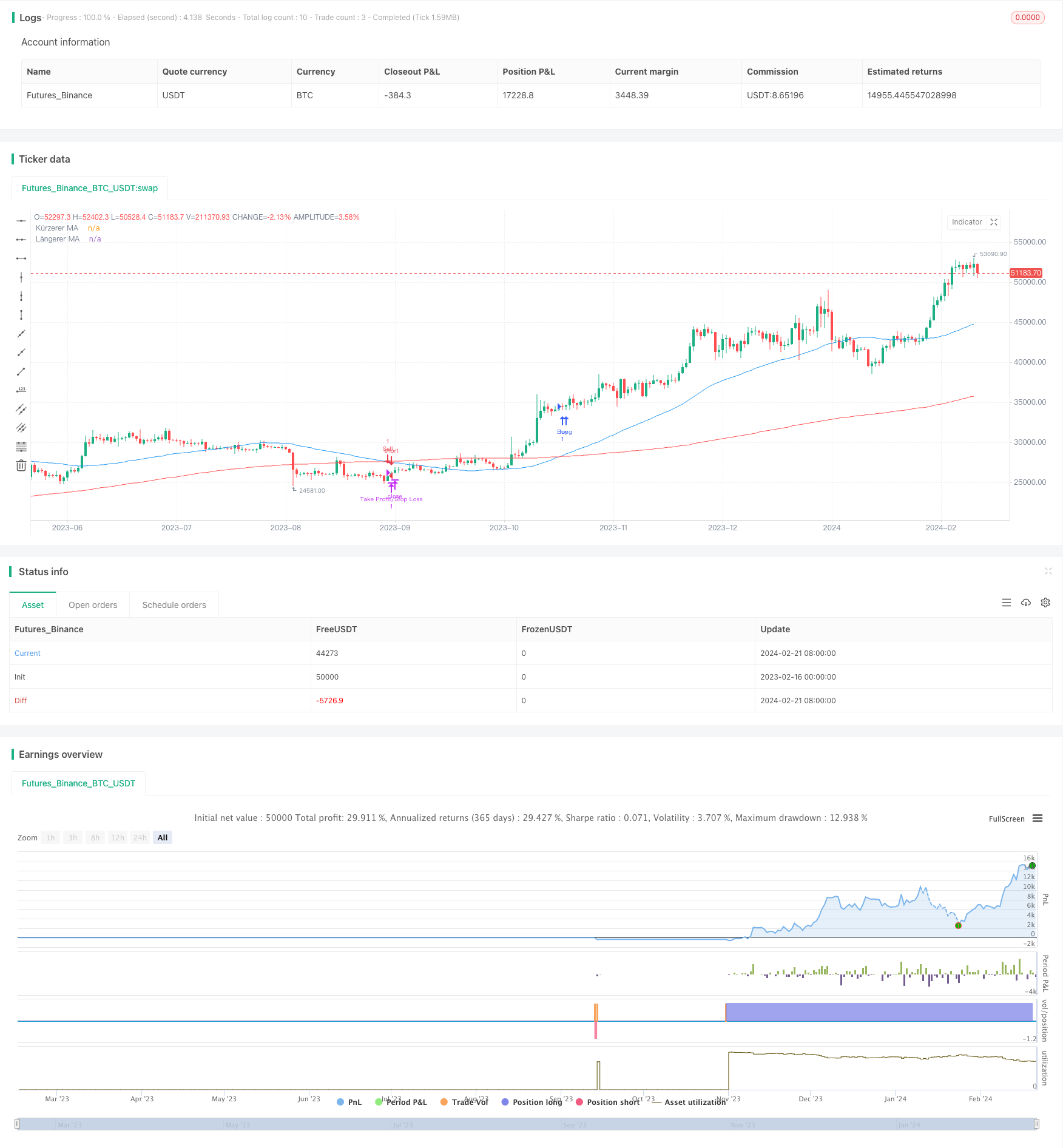
概述
本策略基于移动平均线的金叉死叉原理设计。通过计算快线(短期移动平均线)和慢线(长期移动平均线)的交叉情况,判断市场趋势,实现趋势追踪。当快线从下向上突破慢线时,产生买入信号;当快线从上向下跌破慢线时,产生卖出信号。
策略原理
该策略主要依赖均线交叉原理。快线参数设置为50天,慢线参数设置为200天。计算最近50天和200天的收盘价平均值,分别作为快线和慢线。当快线从下方向上突破慢线时,判断为股票价格进入上升趋势,产生买入信号;当快线从上方向下跌破慢线时,判断为股票价格进入下跌趋势,产生卖出信号。
通过设置不同参数的快慢线组合,可以调整策略的敏感度。快线参数越小,确定趋势的速度更快,但是可能产生更多假信号。慢线参数越大,判断趋势的效果更好,但是确定趋势速度较慢。本策略使用50和200天移动平均线,综合考虑了策略的灵敏度和稳定性。
优势分析
- 使用移动平均线交叉原理,可以有效判断市场走势和趋势转折点,自动追踪趋势运行
- 快慢线参数设置合理,既足够敏感,也能过滤噪音,判断市场趋势效果较好
- 策略理解简单,逻辑清晰,参数设置灵活,容易实现和优化
- 可严格控制止损点,有利于风险控制
风险分析
- 移动平均线策略可能产生较多反转信号或假信号,需要辅助其他指标过滤
- 行情震荡时,可能产生错误交易信号,需要评估特定股票的波动频率
- 停损点设定需要考量个股特性,过于严格可能增加成本,过于宽松可能加大损失
优化方向
- 结合其他技术指标,如MACD、KD等,过滤假信号
- 根据个股特性和波动频率设置移动平均线参数
- 针对高波动股调整止损距离
- 测试不同参数组合优化策略
- 增加开仓和加仓规则
总结
本策略利用均线交叉原理自动判断市场趋势方向并追踪运行,可有效把握主要趋势。通过快慢均线的参数设置控制策略的灵敏度,并辅助其他指标过滤信号可实现策略稳定性和效果的平衡。该策略适合中长线操作,可根据股票和行情特征进行参数调整,扩展入场和止损规则进行优化,从而获得更好的交易效果。
策略源码
/*backtest
start: 2023-02-16 00:00:00
end: 2024-02-22 00:00:00
period: 1d
basePeriod: 1h
exchanges: [{"eid":"Futures_Binance","currency":"BTC_USDT"}]
*/
//@version=5
strategy("Gleitend Strategie", overlay=true)
// Einstellungen für die gleitenden Durchschnitte
short_MA_length = input(50, title="Kürzerer MA Länge")
long_MA_length = input(200, title="Längerer MA Länge")
// Berechnung der gleitenden Durchschnitte
short_MA = ta.sma(close, short_MA_length)
long_MA = ta.sma(close, long_MA_length)
// Kaufsignal: Kürzerer MA über Längerer MA
buy_signal = ta.crossover(short_MA, long_MA)
// Verkaufssignal: Kürzerer MA unter Längerer MA
sell_signal = ta.crossunder(short_MA, long_MA)
// Stop Loss und Take Profit Ebenen
stop_loss = strategy.position_avg_price * 0.985
take_profit = strategy.position_avg_price * 1.02
// Trading-Logik
if (buy_signal)
strategy.entry("Buy", strategy.long)
if (sell_signal)
strategy.close("Buy")
strategy.exit("Take Profit/Stop Loss", "Buy", stop=stop_loss, limit=take_profit)
// Bedingungen für Short-Positionen
if (sell_signal)
strategy.entry("Sell", strategy.short)
strategy.exit("Take Profit/Stop Loss", "Sell", stop=stop_loss, limit=take_profit)
// Plot der gleitenden Durchschnitte
plot(short_MA, color=color.blue, title="Kürzerer MA")
plot(long_MA, color=color.red, title="Längerer MA")